Are you looking for a budget-friendly yet durable cabinet option? You might want to consider thermofoil cabinets.
According to statistics, the national average kitchen cabinets cost is $11,100. Consequently, getting a cheaper alternative to wood cabinets that fits perfectly in a modern kitchen would be a great relief.
Thermofoil cabinets are cheaper than most cabinets made of wood. Our research shows that many homeowners pay about $300 to $350 per linear foot.
Besides, thermofoil water resistance characteristic is admirable. They are perfect for kitchens and bathrooms where cabinets contact water or moisture often.
Like any other material, thermofoil also has both benefits and downsides.
In-depth, let us look at the pros and cons of thermofoil doors to help you make an informed buying decision.
Let us look at the pros and cons of thermofoil cabinets in depth to help you make an informed buying decision.
JUMP TO: About Thermofoil | Pros of Thermofoil Cabinet | Cons of Thermofoil Cabinet |
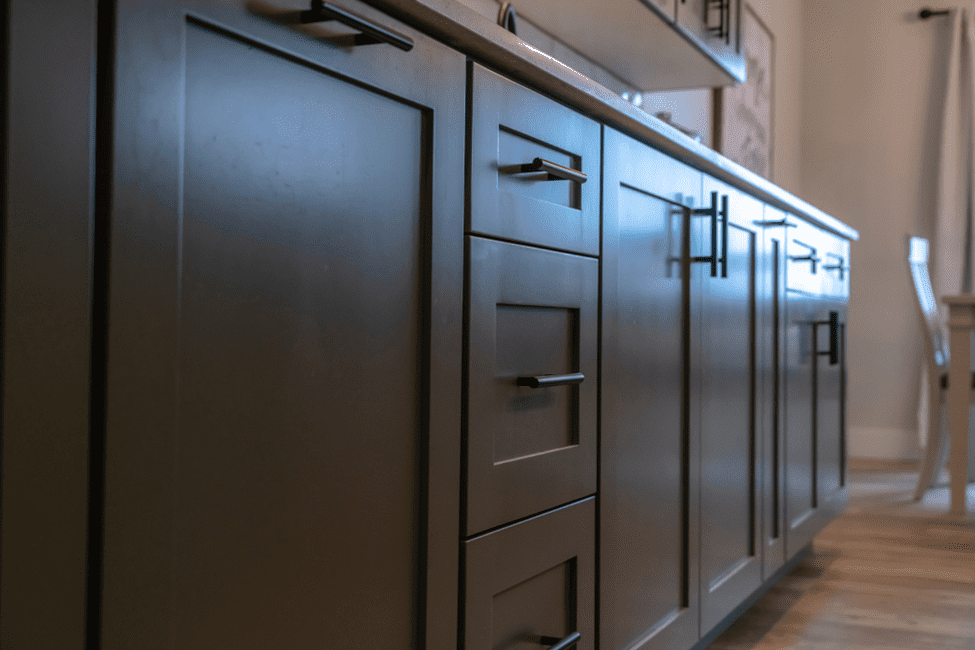
Source: republicite.com
About Thermofoil Cabinets
Despite the word “foil” in thermofoil, there is no metal in this material.
Thermofoil cabinets are made of vinyl material, vacuum-pressed over a medium-density fiberboard core (MDF). Sometimes, Rigid Thermofoil can be a thin layer of PVC instead of vinyl.
The coating is often applied to the front of cabinet drawers and doors. They come in different finishes, styles, and colors. But the standard color for thermofoil is white or off-white.
Many people confuse thermofoil and laminate. Both are smooth and easy to clean. However, the difference is that laminate is glued to the MDF while thermofoil is hot-pressed.
Also, thermofoil is more compatible with fiberboard than laminate.
The best thing about thermofoil cabinets is that you don’t need to paint them.
Pros
Availability
Thermofoil doors are widely accessible, thanks to their massive production.
Most home improvement stores have different thermofoil models in stock and semi-custom designs.
However, most of the readily available thermofoil is either white or off-white. You’ll need to wait a little longer if you want a specific color custom-made.
Cost, Installation, and Repair
Are you looking for a cost-friendly kitchen and bathroom cabinet door? Thermofoil is an ideal choice.
The regular stock thermofoil doors have little or no customization at all. They sell under $100 per linear foot.
Custom and semi-custom thermofoil cost between $300 and $600 per linear foot.
These kitchen cabinets are so easy to install. They don’t require painting, sanding, or sealing. You only need to assemble and fit them into the designated space.
Moreover, repairing the thermofoil cabinet door is straightforward. The most popular and cost-effective way to revamp old cabinets is by refacing them.
The cost of refacing a complete set of thermofoil cabinets is about $1,000. In addition, you can use different designs and colors to reface the cabinets and leave them looking fresh.
Easy Care and Low Maintenance
Thermofoil cabinets have a smooth vinyl surface that resists the buildup of grime and dust. You don’t have to worry about stains because anything that splashes or sticks on these cabinets easily wipes off.
All you need to clean your thermofoil cabinets is a damp cloth and soapy water. Better yet, you can use dish soap or a multi-purpose household cleaner without causing stains or chemical burns on the surface.
Maintaining thermofoil doors is easy. If you keep them clean and away from heat and moisture, they will last for a very long time.
Important Tip: Ensure proper ventilation and air circulation in your kitchen and bathroom cabinets to avoid heat accumulation.
Resistance to warping
Low-quality or traditional wood cabinets tend to warp when exposed to high humidity.
However, this is not the case with thermofoil.
The MDF, aka medium-density fiberboard fibers in the thermofoil, do not flow in one direction. This material holds its shape better, even in humid conditions.
Thermofoil is more resistant to humidity-related bubbling than painted wood.
Sleek, Glossy Finish
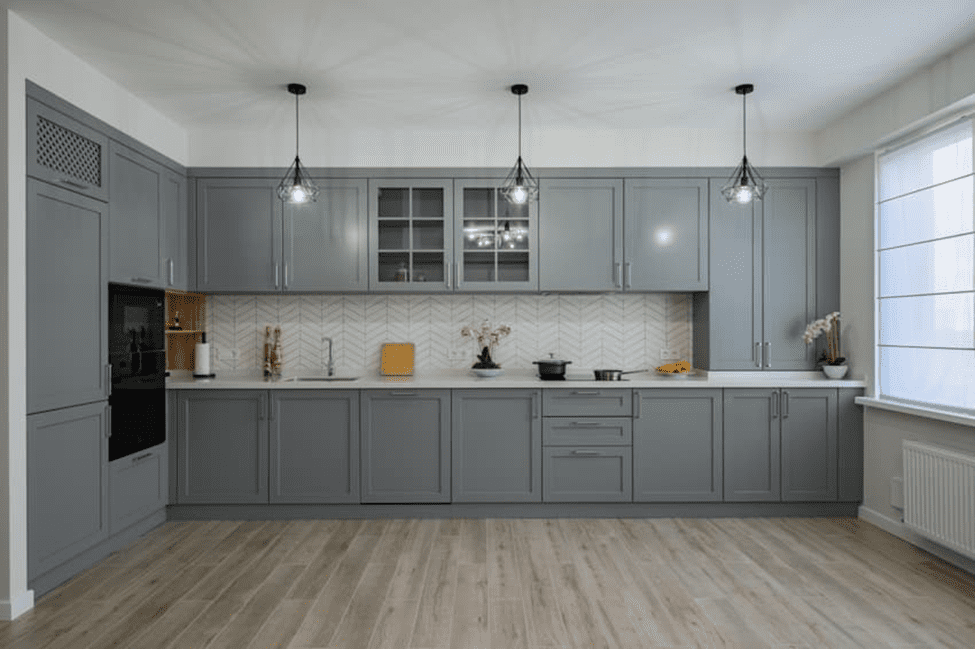
Source: designingidea.com
Thermofoil has a sleek, glossy finish. That’s why they look great in bathrooms or kitchens.
The white or off-white designed fronts are perfect for a modern yet trendy minimalist interior.
A glossy finish gives a more contemporary appeal compared to a matte.
Design and Color Versatility
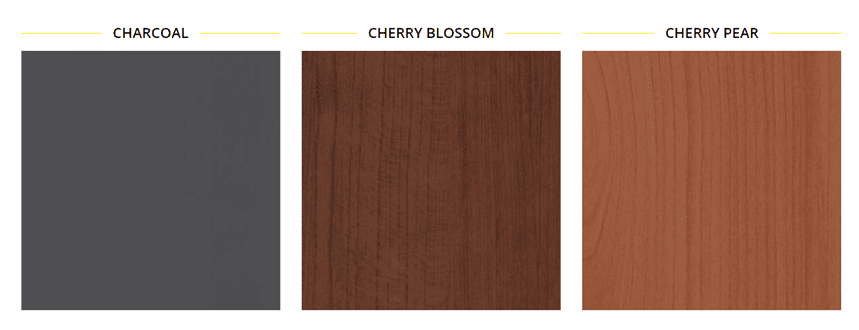
Source: coronamillworks.com
Thermofoil is incredibly versatile and can fit just about any modern aesthetic needs. It comes in various colors, designs, and textures.
White thermofoil cabinet doors with glossy finishes are preferable to most homeowners. They blend well with walls and appliances, providing a sleek, clean look.
Thermofoil allows you to incorporate wood designs into your space without using the actual wood. Most homeowners install thermofoil cabinets that mimic natural wood’s texture and grain.
If you love a luxurious metallic finish, you can incorporate it using thermofoil. Thermofoil metallic finishes come in different colors, like copper, rose gold, and silver.
Moisture Resistance
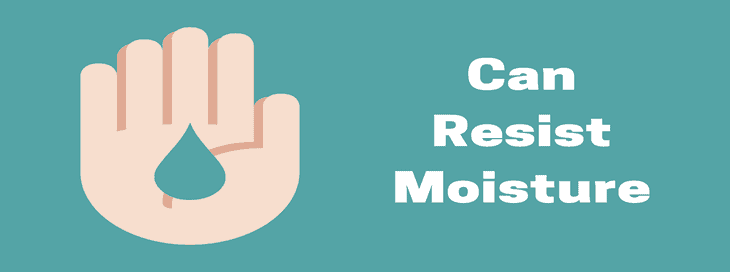
Source: cabinetdoorworld.com
Thermofoil cabinets are non-porous. As such, water cannot penetrate, provided the coating is intact.
For this reason, thermofoil cabinet doors are ideal for the kitchen and bathroom where there is a lot of moisture/ water exposure.
Note: Although thermofoil cabinets are water-resistant, they are not waterproof! If the coating is scratched or damaged, water will seep into the MDF core, causing it to swell or rot.
Durable
Thermofoil cabinets can last for 10 to 15 years. They can effectively stand up to general tear and wear and daily use.
However, the longevity of your thermo cabinets depends on how well you care for them. Prolonged exposure to water and heat or hitting them with blunt objects compromises their durability.
Cons
Peeling
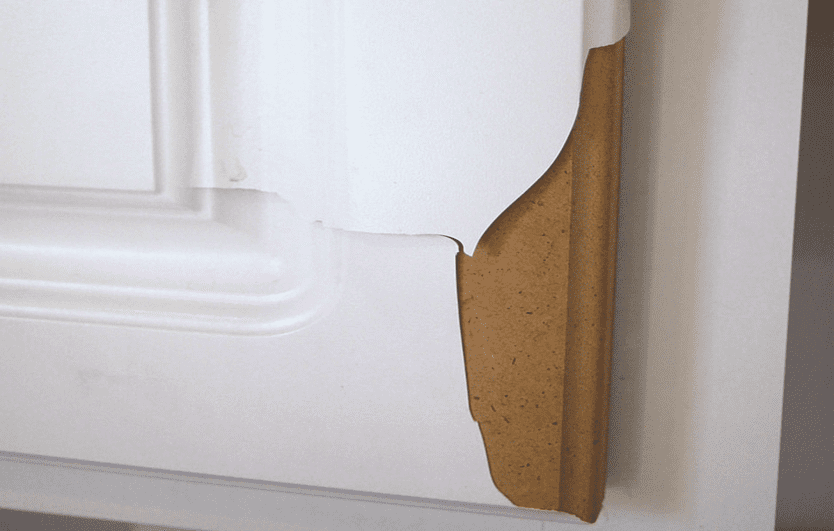
Source: woodreface.com
Thermofoil is pressed on MDF. And just like laminate and veneer, which are pressed or glued on particle board, it starts to peel off after a decade of use.
Moreover, thermofoil is thinner than wood. Consequently, it’s more susceptible to peeling. Exposure to heat also contributes to the peeling of thermofoil cabinets.
When this happens, you can either reface or replace the cabinets.
Plain and Design
Thermofoil cabinets can either have flat fronts, shaker-style fronts, or a simple raised-panel front.
If you are looking for detailed trim work, moldings, or intricate design features, thermofoil is not the best option. Solid wood would do better.
Also, the plain design of the thermofoil does not have that warm homely feel of natural wood.
Water Damage
Thermofoil cabinets are not waterproof, but they are unlikely to warp. However, prolonged exposure of thermofoil cabinets to high humidity and repeated spills could cause them to deteriorate with time.
A scratched or broken thermofoil can absorb moisture. When this water reaches the fiberboard substrate, it causes it to bubble, and the substrate begins to degrade.
Heat Damage
Thermofoil is very susceptible to heat damage. High temperatures cause it to blister or peel.
Therefore, installing your cabinets away from a stovetop, oven, dishwasher, and other high-heat or steam-producing appliances would be good.
Alternatively, you can install a heat shield between the cabinet doors and the appliances.
Note: A heat shield minimizes the steam exposure but does not prevent it entirely.
A kitchen can sometimes get hot. If you are concerned about heat damage, consider using the thermofoil in the bathroom cabinets and choose another material for the kitchen.
Unattractive Aging
A dull yellow cast forms on white and off-white thermofoil as they age. This discoloration results from exposure to heat, sunlight, and lack of proper cleaning or maintenance.
Yellowing also happens on colored thermofoil cabinets, but it’s less noticeable.
Unfortunately, there is no way to remove the yellow color, and this makes your cabinets unattractive.
Aging also causes thermofoil doors to peel and chip.
Heavier than Wood
Do you know that MDF is heavier than engineered wood and solid wood?
For this reason, you will require more effort, screws, and anchors to mount thermofoil cabinets.
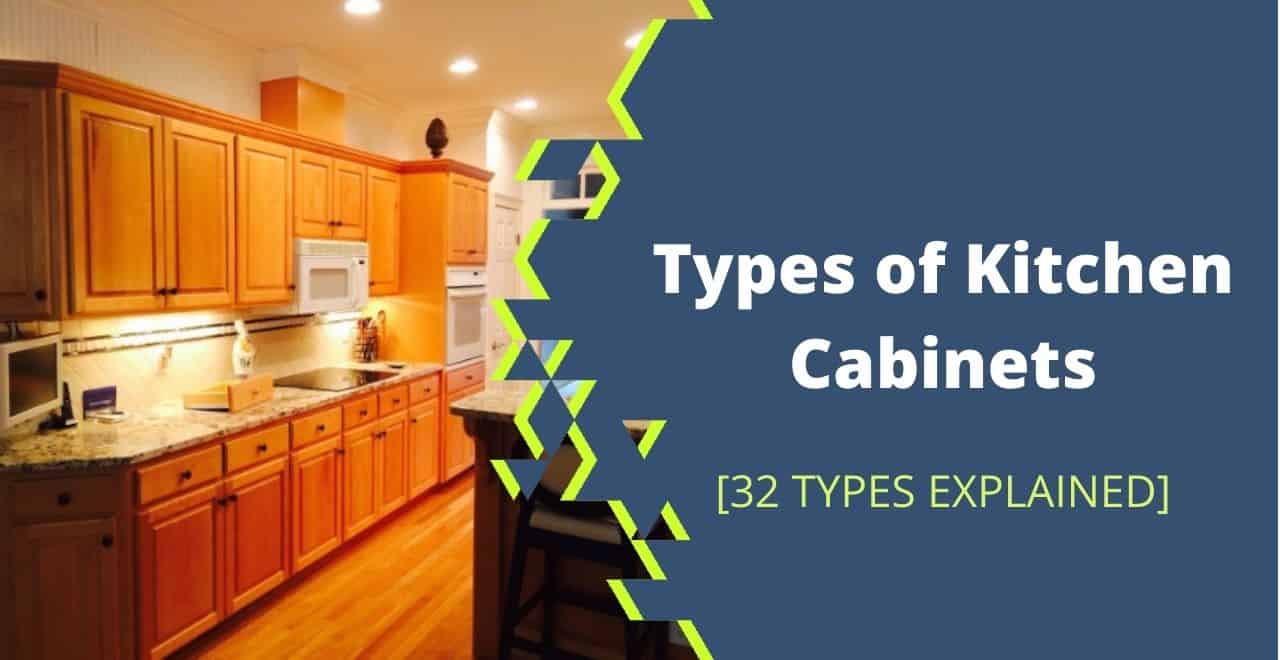
![Granite Vs. Marble Vs. Quartz Countertops [12 Differences+Pros & Cons] Granite Vs. Marble Vs. Quartz Countertops [12 Differences+Pros & Cons]](https://houseadorable.com/wp-content/uploads/2022/03/quartz-marble.jpg)
![How Much Weight Can Kitchen Cabinets Hold? [Explained] How Much Weight Can Kitchen Cabinets Hold? [Explained]](https://houseadorable.com/wp-content/uploads/2022/12/img_63ab44a997e44.png)
![How Much Does It Cost to Build a Kitchen Island? [Custom Made+DIY] How Much Does It Cost to Build a Kitchen Island? [Custom Made+DIY]](https://houseadorable.com/wp-content/uploads/2022/03/cost-of-kitchen-island.jpg)
![How to Choose Kitchen Cabinets [9 Important Tips Included] How to Choose Kitchen Cabinets [9 Important Tips Included]](https://houseadorable.com/wp-content/uploads/2022/10/kitchen.jpg)
![16 Types of Kitchen Cabinet Finishes [Features + Pros & Cons] 16 Types of Kitchen Cabinet Finishes [Features + Pros & Cons]](https://houseadorable.com/wp-content/uploads/2022/10/cabinet-finish.jpg)
![What Are Kitchen Sinks Made Of ? [13 Types+Pros & Cons] What Are Kitchen Sinks Made Of ? [13 Types+Pros & Cons]](https://houseadorable.com/wp-content/uploads/2022/01/Sink-MAterial.jpg)
![Granite vs. Laminate Countertop [Pros and Cons+10 Key Differences] Granite vs. Laminate Countertop [Pros and Cons+10 Key Differences]](https://houseadorable.com/wp-content/uploads/2022/03/Granite-vs.-Laminate.jpg)